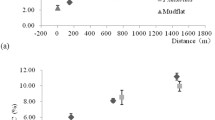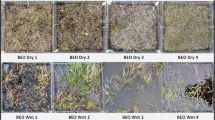Abstract
Although invasions by non-native species represent a major threat to biodiversity and ecosystem functioning, little attention has been paid to the potential impacts of these invasions on methane (CH4) emission and its 13C-CH4-isotope signature in salt marshes. An invasive perennial C4 grass Spartina alterniflora has spread rapidly along the east coast of China since its introduction from North America in 1979. Since its intentional introduction to the Jiuduansha Island in the Yangtze River estuary in 1997, S. alterniflora monocultures have become the dominant component of the Jiuduansha’s vegetation, where monocultures of the native plant Scirpus mariqueter (a C3 grass) used to dominate the vegetation for more than 30 years. We investigated seasonal variation in soil CH4 emission and its 13C-CH4-isotope signature from S. alterniflora and S. mariqueter marshes. The results obtained here show that S. alterniflora invasion increased soil CH4 emissions compared to native S. mariqueter, possibly resulting from great belowground biomass of S. alterniflora, which might have affected soil microenvironments and /or CH4 production pathways. CH4 emissions from soils in both marshes followed similar seasonal patterns in CH4 emissions that increased significantly from April to August and then decreased from August to October. CH4 emissions were positively correlated with soil temperature, but negatively correlated with soil moisture for both S. alterniflora and S. mariqueter soils (p < 0.05). The δ13C values of CH4 from S. alterniflora, and S. mariqueter soils ranged from -39.0‰ to -45.0‰, and -37.3‰ to -45.7‰, respectively, with the lowest δ13C values occurring in August in both marshes. Although the leaves, roots and soil organic matter of S. alterniflora had significantly higher δ13C values than those of S. mariqueter, S. alterniflora invasion did not significantly change the 13C- isotopic signature of soil emitted CH4 (p > 0.05). Generally, the CH4 emissions from both invasive S. alterniflora and native S. mariqueter soils in the salt marshes of Jiuduansha Island were very low (0.01–0.26 mg m-2 h-1), suggesting that S. alterniflora invasion along the east coast of China may not be a significant potential source of atmospheric CH4.


Similar content being viewed by others
References
Bartlett KB, Harriss RC (1993) Review and assessment of methane emissions from wetlands. Chemosphere 26:261–320. doi:10.1016/0045-6535(93)90427-7
Blair N (1998) The δ13C of biogenic methane in marine sediments: the influence of Corg deposition rate. Chem Geol 152:139–150. doi:10.1016/S0009-2541(98)00102-8
Bilek RS, Tyler SC, Sass RL et al (1999) Difference in CH4 oxidation and pathways of production between rice cultivars deduced from measurements of CH4 flux and δ13C of CH4 and CO2. Global Biogeochem Cycles 13:1029–1044. doi:10.1029/1999GB900040
Brand WA (1996) High precision isotope ratio monitoring techniques in mass spectrometry. J Mass Spectrom 31:225–235. doi:10.1002/(SICI)1096-9888(199603)31:3<225::AID-JMS319>3.0.CO;2-L
Chanton JP, Whiting GJ, Blair NE et al (1997) Methane emission from rice: Stable isotopes, diurnal variations, and CO2 exchange. Global Biogeochem Cycles 11:15–27. doi:10.1029/96GB03761
Chanton J, Liptay K (2000) Seasonal variation in methane oxidation in a landfill cover soil as determined by an in situ stable isotope technique. Global Biogeochem Cycles 14:51–60. doi:10.1029/1999GB900087
Chanton JP, Arkebauer TJ, Harden HS et al (2002) Diel variation in lacunal CH4 and CO2 concentration and d 13C in Phragmites australis. Biogeochemistry 59:287–301. doi:10.1023/A:1016067610783
Chen JK (2003) A comprehensive Survey on Jiuduansha Island. Science Press, Beijing
Chen ZY, Li B, Zhong Y et al (2004) Local competitive effects of Spartina alterniflora invasions on Scirpus mariqueter in the Yangtze River estuary, China. Hydrobiologia 528:99–106. doi:10.1007/s10750-004-1888-9
Cheng X, Luo Y, Chen J et al (2006) Short-term C4 plant Spartina alterniflora invasions change the soil carbon in C3 plant-dominated tidal wetlands on a growing estuarine Island. Soil Biol Biochem 38:3380–3386. doi:10.1016/j.soilbio.2006.05.016
Cheng X, Peng R, Chen J et al (2007) CH4 and N2O emissions from Spartina alterniflora and Phragmites australis in experimental mesocosms. Chemosphere 68:420–427. doi:10.1016/j.chemosphere.2007.01.004
Cheng X, Chen J, Luo Y et al (2008) Assessing the effects of short-term Spartina alterniflora invasion on labile and recalcitrant C and N pools by means of soil fractionation and stable C and N isotopes. Geoderma 145:177–184. doi:10.1016/j.geoderma.2008.02.013
Christensen TR (1993) Methane emission from arctic tundra. Biogeochemistry 21:117–139. doi:10.1007/BF00000874
Christensen TR, Lloyd D, Svensson B et al (2001) Biogenic controls on trace gas fluxes in northern wetlands. IGBP-Global Change News Lett 51:9–15
Conrad R (1999) Contribution of hydrogen to methane production and control of hydrogen concentrations in methanogenic soils and sediments. FEMS Microbiol Ecol 28:193–202. doi:10.1111/j.1574-6941.1999.tb00575.x
Conrad R (2005) Quantification of methanogenic pathways using stable carbon isotopic signatures: a review and a proposal. Chem Geol 36:739–752
Conrad R, Claus P (2005) Contribution of methanol to the production of methane and its 13C-isotopic signature in anoxic rice field soil. Biogeochemistry 73:381–393. doi:10.1007/s10533-004-0366-9
Dalal RC, Allen DE, Livesley SJ et al (2008) Magnitude and biophysical regulators of methane emission and consumption in the Australian agricultural, forest, and submerged landscapes: a review. Plant Soil 309:43–76. doi:10.1007/s11104-007-9446-7
Ding WX, Cai ZC, Tsurata H et al (2003) Key factors affecting spatial variation of methane emissions from freshwater marshes. Chemosphere 51:167–173. doi:10.1016/S0045-6535(02)00804-4
Dunfield P, Knowles R, Dumont R et al (1993) Methane production and consumption in temperature and subarctic peat soils: response to temperature and pH. Soil boil Biochem 25:321–326
Edward R, Hornibrook C, Jongstaffe FJ et al (2000) Evolution of stable carbon isotope composition for methane and carbon dioxide in freshwater wetlands and other anaerobic environments. Geochim Cosmochim Acta 64:1013–1027. doi:10.1016/S0016-7037(99)00321-X
Ehrenfeld JG, Kourtev P, Huang W (2001) Changes in soil functions following invasions of exotic understory plants in deciduous forests. Ecol Appl 11:1287–1300. doi:10.1890/1051-0761(2001)011[1287:CISFFI]2.0.CO;2
Ehrenfeld JG (2003) Effects of exotic plant invasions on soil nutrient cycling processes. Ecosystems (N Y, Print) 6:503–523. doi:10.1007/s10021-002-0151-3
Fey A, Claus P, Conrad R (2005) Temporal change of 13C-isoyope signatures and methanogenic pathway in rice field soil incubated anoxically at different temperatures. Geochim Cosmochim Acta 68:293–306. doi:10.1016/S0016-7037(03)00426-5
Flessa H, Rodionov A, Guggenberger G et al (2008) Landscape controls of CH4 fluxes in a catchment of the forest tundra ecotone in northern Siberia. Glob Change Biol 14:2040–2056. doi:10.1111/j.1365-2486.2008.01633.x
IPCC (2007) Climate Change 2007: The Scientific Basis. Cambridge University Press, New York, USA
Joabsson A, Christensen TR, Wallén B (1999) Vascular plant controls on methane emissions from northern peatforming wetlands. Trends Ecol Evol 14:385–388. doi:10.1016/S0169-5347(99)01649-3
Kostka JE, Roychoudhury A, Van Cappellen P (2002) Rates and controls of anaerobic microbial respiration across spatial and temporal gradient in salt marsh sediments. Biogeochemistry 60:49–76. doi:10.1023/A:1016525216426
Krüger M, Eller G, Conrad R et al (2002) Seasonal variation in pathways of CH4 production and in CH4 oxidation in rice fields determined by stable carbon isotopes and specific inhibitors. Glob Change Biol 8:265–280. doi:10.1046/j.1365-2486.2002.00476.x
Kutzbach L, Wagner D, Pfeifer EM (2004) Effect of microrelief and vegetation on methane emission from wet polygonal tundra, Lena Delta, Northern Siberia. Biogeochemistry 69:341–362. doi:10.1023/B:BIOG.0000031053.81520.db
Laine A, Wilson D, Kiely G et al (2007) Methane flux dynamics in an Irish lowland blanket bog. Plant Soil 299:181–193. doi:10.1007/s11104-007-9374-6
Li B, Liao C, Zhao XD et al (2009) Spartina alterniflora invasions in the Yangtze River estuary, China: an overview of current status and ecosystem effects. Ecol Eng 35:511–520. doi:10.1016/j.ecoleng.2008.05.013
Liao CZ, Luo YQ, Fang CM et al (2008) Litter pool sizes, decomposition, and nitrogen dynamics in Spartina alterniflora-invaded and native coastal marshlands of the Yangtze Estuary. Oecologia 156:589–600. doi:10.1007/s00442-008-1007-0
Liao C, Luo Y, Jiang L et al (2007) Invasion of Spartina alteriflora enhanced ecosystem carbon and nitrogen stocks in the Yangtze Estuary, China. Ecosystems (N Y, Print) 10:1351–1361. doi:10.1007/s10021-007-9103-2
Lin GH, Ehleringer JR, Rygiewicz PT et al (1999) Elevated CO2 and temperature impacts on different components of soil CO2 efflux in Douglas-fir terracosms. Glob Change Biol 5:157–168. doi:10.1046/j.1365-2486.1999.00211.x
Liikanen A, Flǒjt L, Martikainen PJ (2002) Gas dynamics in eutropic lake sediments affected by oxygen, nitrate, and sulfate. J Environ Qual 31:338–349
Lovley DR, Phillips EJP (1987) Competitive mechanism for inhibition of sulfate reduction and methane production in the zone of ferric iron reduction in sediments. Appl Environ Microbiol 53:2636–2641
Minkkinen K, Laine J (2006) Vegetation heterogeneity and ditches create spatial variability in methane fluxes from peatlands drained for forestry. Plant Soil 285:289–304. doi:10.1007/s11104-006-9016-4
Moosavi SC, Crill PM (1998) CH4 oxidation by tundra wetlands as measured by a selective inhibitor technique. J Geophys Res 103(D22):29093–29106. doi:10.1029/97JD03519
Neubauer S, Givler K, Valentine S et al (2005) Seasonal patterns and plant-mediated controls of subsurface wetland biogeochemistry. Ecology 86:3334–3344. doi:10.1890/04-1951
Nykǎnen H, Alm J, Silvola J et al (1998) Methane fluxes on boreal peatlands of different fertility and the effect of long-term experimental lowering of the water table on flux rates. Global Biogeochem Cycles 12:53–69. doi:10.1029/97GB02732
Penning H, Plugge C, Galand P et al (2005) Variation of carbon isotope fractionation in hydrogenotrphic metahanogenic microbial cultures and environmental samples at different energy status. Glob Change Biol 11:2103–2113. doi:10.1111/j.1365-2486.2005.01076.x
Powelson DK, Charlton JP, Abichou T (2007) Methane oxidation in biofilters measured by mass-balance and stable isotope methods. Environ Sci Technol 41:620–625. doi:10.1021/es061656g
Qin P, Zhong CX (1992) Applied studies on spartina. Ocean Press, China
Rodhe H (1990) A comparison of the contribution of various gases to the greenhouse effect. Science 248:1217–1219. doi:10.1126/science.248.4960.1217
Rolston DE 1986. Gas flux. In Klute A (eds) Methods of Soil Analysis. The 2nd Edition, Monograph No. 9. American Society of Agronomy and Soil Science Society of America, Wisconsin, pp1103-1119.
Roden EE, Wetzwel RG (1996) Organic carbon oxidation and suppression of methane production by microbial Fe (III) oxide reduction in vegetated and unvegetated freshwater wetland sediments. Limnol Oceanogr 41:1733–1748
Rustad JC, Skinner JH, Marion GM et al (2001) A meta-analysis of the response of soil respiration, net nitrogen mineralization, and above-ground plant growth to experimental ecosystem warming. Oecologia 126:543–562. doi:10.1007/s004420000544
Schimel JP (1995) Plant transport and methane production as controls on methane flux from arctic wet meadow tundra. Biogeochemistry 28:183–200. doi:10.1007/BF02186458
Towprayoon S, Smakgahn K, Poonkaew S (2005) Mitigation of methane and nitrous oxide emissions from drained irrigated rice fields. Chemosphere 59:1547–1556. doi:10.1016/j.chemosphere.2005.02.009
Van der Nat FJWA, Middelburg JJ (2000) Methane emission from tidal freshwater marshes. Biogeochemistry 49:103–121. doi:10.1023/A:1006333225100
Venkiteswaran JJ, Schiff S (2005) Methane oxidation: isotopic enrichment factors in freshwater boreal reservoirs. Appl Geochem 20:683–690. doi:10.1016/j.apgeochem.2004.11.007
Wang Q, An S, Ma Z et al (2006a) Invasive Spartina alterniflora: biology, ecology and management. Acta Phytotaxon. Sin. 44:559–588. doi:10.1360/aps06044
Wang Q, Wang CH, Zhao B et al (2006b) Effects of growing conditions on the growth of and interactions between salt marsh plants: implications for invasibility of habitats. Biol Invasions 8:1547–1560. doi:10.1007/s10530-005-5846-x
Whiting GJ, Chanton JP (1993) Primary production control of methane emission from wetlands. Nature 364:794–795. doi:10.1038/364794a0
Wilson D, Alm J, Laine J et al (2009) Rewetting of cutaway peatlands: Are we re-creating hot spots of methane Emissions? Restor Ecol. . doi:10.1111/j.1526-100X.2008.00416.x
Acknowledgements
This study was financially supported by National Basic Research Program of China (No. 2006CB403305), National Science Foundation of China (No. 30670330), and Ministry of Education of China (No. 20050246013). We thank Dr. Weixin Ding, Xiaoping Li and Leyi Li for lab analysis, and Chenghuan Wang, Zhichen Wang, Yongjian Gu, Haiqiang Guo and Jing Xie for their assistance with field sampling
Author information
Authors and Affiliations
Corresponding authors
Additional information
Responsible Editor: Klaus Butterbach-Bahl.
Rights and permissions
About this article
Cite this article
Cheng, X., Luo, Y., Xu, Q. et al. Seasonal variation in CH4 emission and its 13C-isotopic signature from Spartina alterniflora and Scirpus mariqueter soils in an estuarine wetland. Plant Soil 327, 85–94 (2010). https://doi.org/10.1007/s11104-009-0033-y
Received:
Accepted:
Published:
Issue Date:
DOI: https://doi.org/10.1007/s11104-009-0033-y




